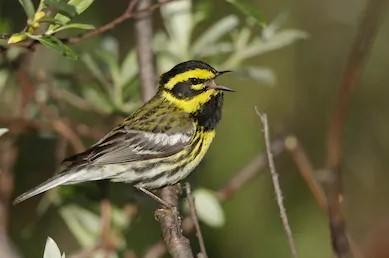Townsend's Warbler

Our bird of the month for February is the Townsend's Warbler. The latin name is Setophaga Townsendi. It is an adorable little bird that is not a usual backyard visitor but it is fairly easy to identify when it does arrive. The males have a distinctive pattern of black and white stripes on the wings and tail and a similar pattern on the body that blends into an olive back and yellow torso. The head and throat are black with large yellow cheek patches, a smaller black patch on top of the yellow cheek that encircles the eye, and a final small yellow patch underneath the eyes. The females and juveniles are lighter in color but don't have the same black throat patch.
Even though they are a common and widespread bird, they prefer to inhabit conifer forests and spend most of their time in the canopy where they can glean food in the form of insects, insect larvae, and small seeds. Their home range extends from Alaska to Oregon for most of the year. During the colder months of winter they spread out along a thin strip of the Pacific Coast, Mexico, and Central America. They change their feeding strategy at this time and are more likely to be seen at feeders feasting on suet, berries, and mealworms. In Mexico they are known to mostly feed on the honeydew nectar of small scaled insects for energy.
During the warmer months of spring, nesting habits will begin. There are no unique mating behaviors practiced by Townsend's Warblers. The nest is constructed out of grass stems, small twigs, pine needles, and lined with moss, feathers, and spider silk for insulation. It is not known if the nest is solely constructed by the female or if the male also participates. The ideal location for these small nests is on top of conifer branches at a height range of 7'-60' above the ground.
The breeding territory of Townsend's Warbler starts above North-western Canada and flows South through Canada and into Alaska, North Western and Central Washington and down into Oregon. There have been reports of Townsend's Warblers either pushing out the similar Hermit Warblers or crossbreeding with them where territories overlap. Breeding begins in late May and the first eggs will be present by the end of June. There are always at least 3 eggs but, more commonly, 4-5 are produced. There will only be one brood each year. The tiny eggs are white with brown markings and are possibly incubated by both sexes. Normal incubation will occur for 11-14 days and, after hatching, a nesting period of 9-11 days is needed for growth before the babies fledge.
A Couple of Interesting Facts
- The Townsend's Warbler was first identified near the mouth of the Columbia River in what is now known as Oregon in 1835 by Jon Kirk Townsend, an American naturalist.
- Sometimes a female Townsend will partially construct a nest in one tree and then move all the materials to another tree and finish the nest there.

